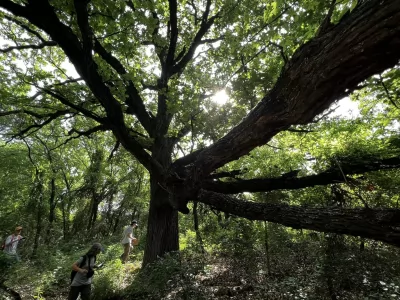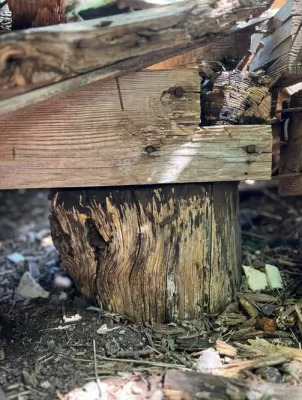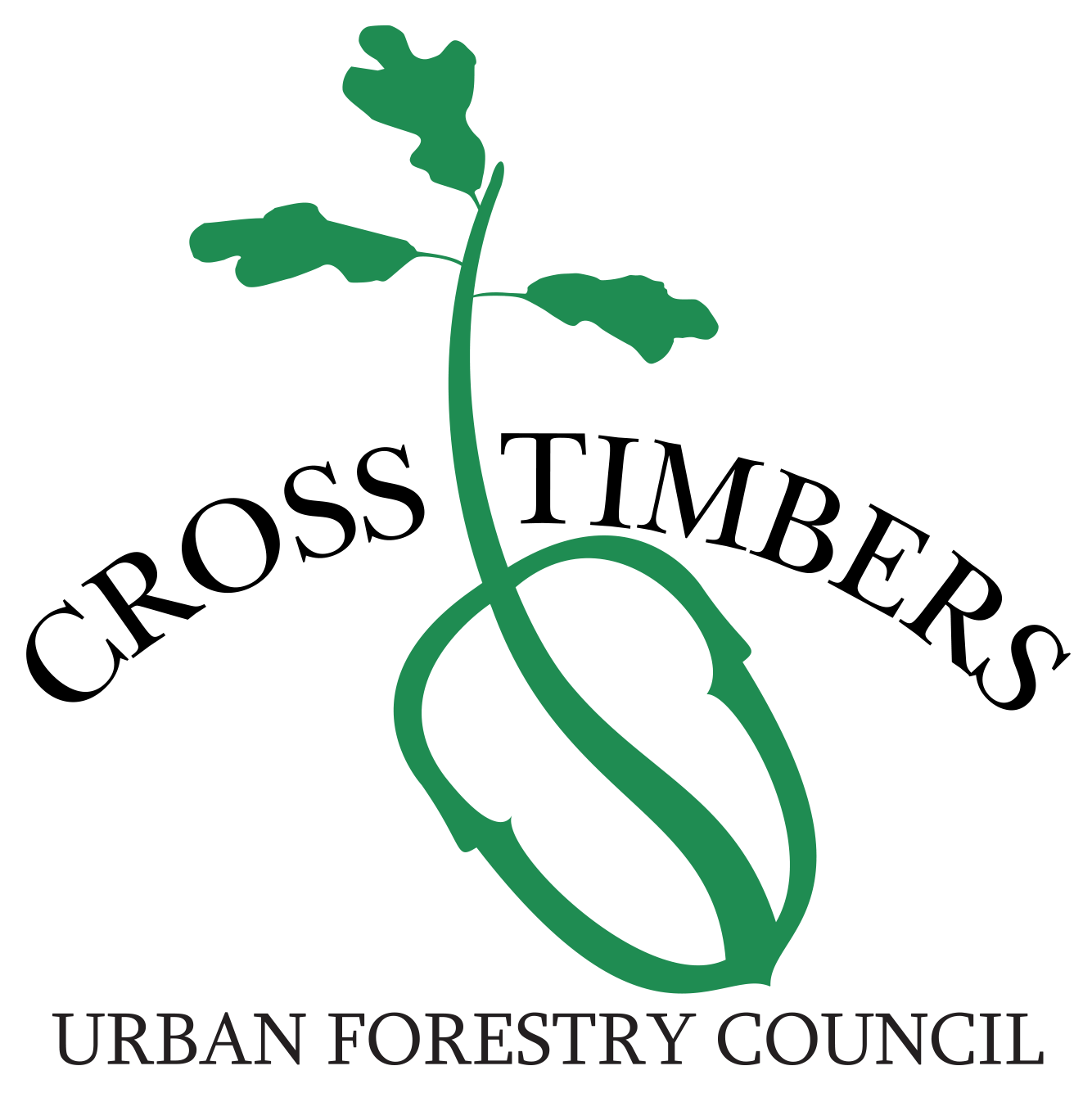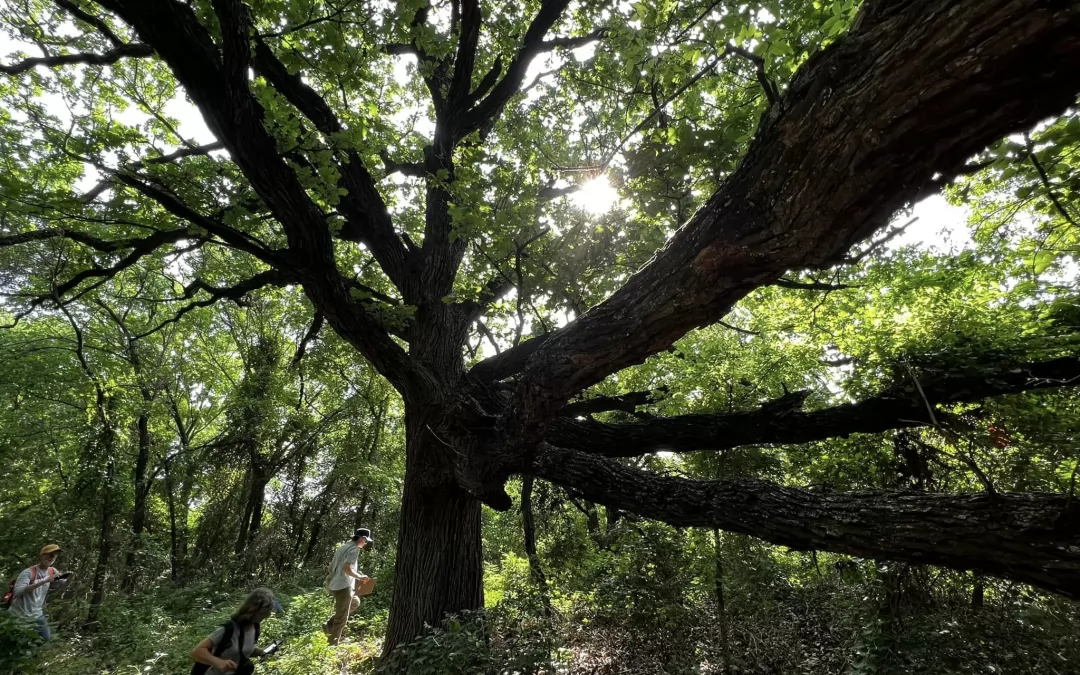Park by Park—Surveying the Trees of North Texas by Jerry Hamby
(This article was originally published in the Elm Fork Chapter Texas Master Naturalist newsletter.)
When an abandoned golf course near my house in Houston was developed into a nature park called Exploration Green in 2014, I volunteered to help oversee an onsite tree nursery. For seven years I organized work events and the planting of 1,500 native trees in the park. After moving to Denton in 2021, Rick Travis invited me to participate in a tree survey at Coppell Nature Park. Rick, who has a degree in Forestry and Environmental Science, had done similar work in the past, often at the request of city officials.

Survey Team on the Trail at Coppell Nature Park
The purpose of the Coppell survey was to provide an inventory of trees and selected plants in the 66-acre park. A little-known jewel in north Dallas County, Coppell Nature Park is a ten-minute drive from DFW International Airport. For our work Rick divided the park into six zones with the goal of covering them over a five-week period. Each weekly survey took approximately three hours to complete and involved the participation of ten volunteers.
At first we hiked the trails that meander through the park, but we eventually ventured deeper into the woods and down ravines to get a full count. In organizing the survey, Rick divided the identification of species into three categories—canopy, understory, and ground cover and vines. Rick led the way, identifying and counting trees while a designated counter walked behind and, clipboard in hand, tallied the results. To facilitate the process, Rick printed a list of species commonly found in North Texas. Only canopy trees were counted; understory and other species were noted as being present. Other volunteers helped Rick spot trees and low-growing plants that might be easily overlooked, such as the tiny yellow passionflower (Passiflora lutea) growing near Cottonwood Branch, the waterway that runs through the park.
This survey, like others Rick subsequently completed, had several goals, the most important of which was to provide baseline data. In the case of Coppell Nature Park, the Education Director of the Biodiversity Center, Cynthia Contreras, wanted to know how much of the woodland forest was native and where to address deficits (through future plantings). It turns out that the largest and oldest trees—particularly post oak (Quercus stellata), pecan (Carya illinoinensis), and eastern cottonwood (Populus deltoides)—are species commonly found in the Eastern Cross Timbers habitat that makes up much of the park. More recent forest succession was evident in the southeast corner of the park, where there was a high concentration of cedar elms (Ulmus crassifolia), accounting for almost one-fifth of the total trees.
Rick’s formal report on the survey also highlighted sections of the park where invasive species of trees and shrubs were crowding out native vegetation. Of particular note was a large infestation of privet, primarily Ligustrum quihoui, in one area. Other invasive species were also spreading throughout the park, including callery pear (Pyrus calleryana), heavenly bamboo (Nandina domestica), and Chinese pistache (Pistacia chinensis). Specifying where these invasive plants were most prevalent made it easier for Contreras and Park Department officials to formulate an eradication plan.
In 2022 and 2023 Rick completed several more tree surveys in which I participated, including one for the Pratt Nature Preserve, an eight-acre section of Sycamore Bend Park that had been set aside for conservation by the town of Hickory Creek in Denton County. In the preserve Rick observed 148 ash trees (genus Fraxinus), constituting seventeen percent of the total tree population. All ash species are susceptible to the emerald ash borer (Agrilus planipennis), an invasive beetle that destroys almost every ash tree in its path. Post oaks accounted for forty-four percent of the trees at Pratt (a total of 393 trees). Dinah Stults, a Texas Master Naturalist who oversees volunteer work in the preserve, knew that the parcel of land was densely wooded but was surprised that there were nearly 900 canopy trees. Sharing the survey results with the Hickory Creek Town Council helped Stults bolster the case for protecting the site from future development.
Rick’s most ambitious survey of 2023 took place at Grand Park in Frisco. Between April and June, Rick led volunteers through twelve sections that he defined using Google Maps. This new public green space covers 275 acres, but there are plans to extend the park to more than 1,000 acres, an area larger than Central Park in New York City. Frisco’s Parks and Recreation reached out to Rick for input into the Grand Park master plan. Because the park is largely undeveloped and is bisected by Stewart Creek, most of the areas surveyed were densely wooded or sloped toward the waterway. We accessed those sections via the only trail in the park, the two-mile Big Bluestem Trail, which opened to the public in late 2022.

150-Year-Old Bur Oak (Grand Park)
The final count of 5,700 canopy trees represented twenty species, eighteen of which are native to North Texas. More than eighty percent of the trees counted were cedar elm, sugar hackberry (Celtis laevigata), and ash, suggesting that most of the forest is relatively young. While there weren’t many oaks in the park, Rick estimated that one of the few bur oaks (Quercus macrocarpa) we spotted was at least 150 years old, and he recorded several other major Cross Timbers species, including 185 American elms (Ulmus americana) and 174 Osage orange trees (Maclura pomifera). This last species, also called a bois d’arc, is known for its ability to resist rot and insect damage. Remnants of the early twentieth century Wollenreich homestead, buried deep in the woods near Stewart Creek, bear witness to this fact. Although the roof and most of the walls of the house have collapsed, the floor beams still rest on completely intact bois d’arc foundation blocks. Because the homestead site represents a danger to the public, these ruins will be stabilized or removed.

Bois D’arc Foundation Block (Grand Park)
In preparing his final report to Frisco Parks and Recreation, Rick ranked sections of Grand Park according to their ecological valuations. He labeled areas that contained a high density and diversity of native flora as being of highest value while areas dominated by non-native and invasive plants were deemed to be of low value. He recommended that park amenities, including a proposed Nature Learning Center, be developed in the areas of lowest ecological value and that the sections of highest value be preserved for their biodiversity and aesthetic value.
To demonstrate the importance of two sections, in particular, Rick organized a series of BioBlitzes and highlighted the results in his formal report. Over the course of several weeks, 102 participants uploaded approximately 7,000 observations on iNaturalist, including 300 species of flora and 600 species of fauna. One of the events was led by Sam Kieschnick, Urban Wildlife Biologist with the Texas Parks and Wildlife Department. An area of particular interest is a large prairie meadow on the southeast side of the park. On the day I visited the meadow, hundreds of butterflies and bees covered the native wildflowers and grasses.
My work with Rick came full circle in April 2024 when I helped with a tree survey at Furneaux Creek Nature Trail in Carrollton. It was my early association with Richard Johnson that led to my working with Rick. When I met Richard in 2021, he was leading volunteer work at Furneaux Creek and wanted help in creating an inventory of the trees. Like most natural sites, Furneaux Creek has its share of invasive plants, and the species of greatest concern is Chinese tallow (Triadica sebifera). In the forests of East Texas, there are more 340 million mature Chinese tallows, and while this highly aggressive species is not as problematic in North Texas, its presence is a reminder of why the tree surveys Rick conducts are so important, especially in protecting native species from plants that threaten to displace them. At Furneaux Creek Chinese tallows accounted for eleven percent of the canopy species, outnumbered only by black willow (Salix nigra) and ashes. Knowing the extent of the problem, Carrollton city officials can formulate a plan for eradicating this invasive species.
I continued working with Rick this summer as he completed a second tree survey for the City of Frisco. This time he inventoried trees in the Sontag Tract, which connects Grand Park to the Stewart Creek Wetlands Preserve. One of the goals was to make recommendations for extending public walking trails. This was my first survey since completing Citizen Forester training in the spring, and knowing that, Rick asked me to lead the count for two of the sections. Two of my classmates participated as well, and all three of us were pleased to be able to apply our training and knowledge to such an important project.

